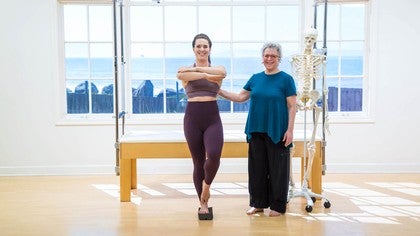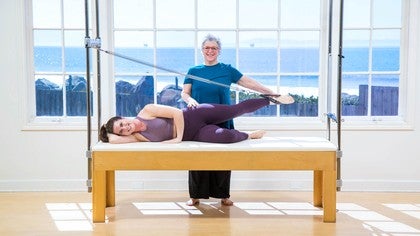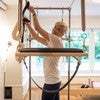Description
About This Video
Transcript
Read Full Transcript
So in this tutorial we're going to talk about open chain and closed chain. And I'm a perfect example of why I need to do closed chain because I have ACL tears in both knees and I was have a great Pilates practice, but I, there were times I had trouble walking up the stairs. And so doing the closed chain really change, you know, there's a different coordination that has to happen in your bones and your muscles when you're in standing. And why is that? Because in standing, so here, you know, this, if I'm just doing this, this would be closed. I mean open chain so that I'm not using any forces of grounding to change it.
And so the bones have a little different organization. When I'm in open change, especially the leg bones compared to the arm boats. So when I'm have the foot grounded, it's going to have a different kind of coordination. And what happens, they call it the screw home mechanism is the knee, the condos are rolling on the knee. And that's really when the ACL and the meniscus is real important.
Cause it's kind of coordinating that, that, um, condyles are trying to stay centered on the knee and most of injuries are happening at the knee in like athletics is at when they're, it's been, when it comes to a straight leg, those condos come right locked in onto those what's called the tibial plateau. And so that is a really important organization when there is misalignment or like with me with a ACL. So my whole thing could be spinning. So that's where my physicality has to work tremendously. And then that is by doing this, this is working on keeping that coordination. And then it's also, we're gonna go over all the things that help coordinate this knee, which then also goes into the hip.
So we're gonna look at Noel. So she's gonna stand for, she'll stand forward and look. So you can see that her knees are turning in and then it's going out. And it's not that if, um, when we talked about bone rhythms and one way she's going too far in her bone rhythms and what does that mean? So, uh, play and visualize your fibula and or your tibia turning out. No turning in. I'm sorry. And now turn it out. As you straighten her, your legs, go ahead and keep out. Keep turning out.
There we go. So what happens with um, a hyperextension and I can show you on my leg is what happens is I'm doing good, I'm doing good. And then I go back to turning the fibrillin and then it changes the alignment of a leg. So that's a different coordination I have to have for uh, especially hyperextended knees. Then if you look at her sideways profile, look again how those shins are moving backwards and she's doing a little bit of a, uh, pelvic shift forward. And I did this for years because my legs are back here and the only way to get my pelvis forward is to push the pubis forward.
What happens when then is I don't get that post to your lateral leg. I don't get the legs to do its work. So we're going to start up the chain, uh, within the tutorials. You know, you'll will be going to the feet. I won't go to the feet today on this, um, evaluation, but in go back to those tutorials and we'll bring it also fully into the reformer workout. So she's gonna stand on these minis and she's gonna have her foot or art in the middle of that. So she has to find where she can be on them. Go ahead.
There we go. And she's going through some reflexes. And what's happening is we talked about this. The gastrocnemius is doing much more work and with these minis, she can't use her toes to grip. So it's kind of beginning to change her feeling about that. Now I want you to bring your heels, uh, you're gonna stand with your heels on the minis and your toes on the floor.
More and more and more. More and more and more. There we go. Even more. Go ahead. There you go. So what we want her to think about is she's going to go a tiny millimeter Relevate and she's already starting to shift forward and she's going to go straight up and that's it. And then lift up, lift your heels up to the back of your knees without shifting her pelvis fault. Bring your brain back. There you go. And go ahead, lift. Oh, she, she's really weak there. There we go. And lift. And there we go. And what's happening?
It's great as she's trying to do it and go straight up there. Post lateral leg is starting to work now she's going to bring one foot forward, flex her ankle. So she's standing on one leg. Good. Flex your foot fiercely. And now try Relevate you're here. I'm here for you and you're going to go, she wants to go forward. And I want milometer. Thank you. Thank you. Great. And now do the other side. I'll be on the side for you.
Go ahead. Get that. Oh, she's starting to shift forward. Get that brain back over the mini. There you go. And lift your heel up. There we go. And Oh my. And it's great as she's doing it. That's great. And then good. Now Stan profile again for everyone to the camera.
And do you see how our shins are starting to change? And, and what also I could see is that dimple was coming in, which was really lovely. So now we're gonna start building up and get her a little bit more conscious of the back of her leg. So I want her to lie sideways with her head that away.
Sh sh I can feel, I feel I'm listening to her and I feel she wants to kick forward. And my goal for her is I'm going to let go and right where my hand is, is where I want her to hold it. I'm going to let go and she's having some, there we go. She or her brain wants to use this for everything. Come back. Come back to me. Come back. And you're gonna no, don't talk on me. There we go. Hold it. Oh, there you go.
So it'll be great when, as teachers to practices and then you can just listen. That's all I'm doing. I'm not doing any work. And what I want her to get this to hold and that's what I feel. She's, she's such a good mover. She knows how not to do that. So you're going to hold it. There you go. Lower the leg down, lift it back up.
There we go.
Now do you see I'm to, I'm going to bring her leg back and I gonna give her, flex your foot fiercely. And so there's that gluteus also working back here. I'm going to still get her, she's going to feel like she's way back. But if we were you, she has a pretty good head tail connection. I'm going to let go and I want to see if she can hold that.
So do you see how it's starting to get a little bit more plum line and what's great? I might do a couple reps of this and then start the whole workout. So it doesn't have to be a big thing, but it gets everything going. Lying on your back please.
There are so many wonderful variations of different kinds of bridging that um, can help wake up those gluteals. So what I want her to, uh, put her hands on her sip bones and I want to, the image in when we talked about the hamstrings is having the sip bones in low beam and you're driving your sit bones. Okay? She's gonna gradually move this sip bones to middle beam, to high beam as she bridges up. So she's going to force her knees forward. Go ahead. More, more, more. Okay. And I'm bringing her, squeeze me, squeeze me. I feel nothing good. And then she's going to lower the whole thing down again. Widen. Squeeze me gray.
And I'm really making sure she stays parallel because a lot, if I start, start the tailbone first, please. Do you see the knees are going to start turning out. And if you put your hand here, that loosens up. So go back to neutral. So I'm calling this pelvic shift forward from Irma guard, bartender. And I really want her to come on lift. Thank you so much. Nice. Together.
There you go. Give me a little spinal extension as well. Lift. There you go. Arch arch. That's it. That's it. And then slowly lower down. Why didn't your sit bones good? There we go. That was great. That was great. Coming down. Come back up to standing.
So this is, um, and you're going to put, uh, your left foot to Relevate left foot, uh, on the floor. There you go. Now if you look at it, she's starting to get that dimple to come in and her alignment of her leg is getting better. I'm going to, I call this mini tree. So she's going to take her left foot and put it on her right shin, right in front, right front here. And then I want you to squeeze your outers, your, your, your cath to your shin more and more and more. More and more and more. And then she's going to bring her weight back on her heel. There we go.
That's it. That's great. Now this is going to be tiny. I want her to rotate from her hip, so her hips face to the left. So she's trying to do it from a ribs and it's very tiny. And then she's going to bring the whole thing back and she's gonna rotate.
She's kinda hiking up now. She's losing that and rotate and she's working really hard. I call this L B, M's. Little bitchy movements. Thank you. There you go. Stand off of there. Feel what that feels like. Just stand off. Good. Now put your hand, uh, sand profile again.
So put your hands on your sip phones, bring the weight back on your heels. Now I don't have her in the correct place, but if I, she goes back to tucking, she'll never start learning the coordination she needs for standing. So I want her to visualize the sip bone sliding closer to the back of the knees and the back in the cert CLA sliding closer to the heels and then the heels start sliding closer to the foot. And so that's getting that whole back line happening. And probably what is looking good is once you get that back line activate, it sometimes naturally just lifts your hip, the front body up.
So see if you can keep that right leg coordination to do a left passe copay. And she wants, she's starting to hyperextend. So what I want her to, I'm going to put my foot here. I'm her little friend. Stand on your right leg and lift your leg up. Come on, come on. Come on. There we go. Yes. Yes. That was great.
And she's working really hard. Thank you so much and great. And what's a turn around face the back. We didn't talk about this, but a lot of times when clients are really, or yourself are weak and they go on their leg, they brace down in their backs. So when she was lifting, go head back on that leg. This got much freer. Once you get those legs doing work, you could do anything on top and still be strong. Okay? We're going to come over to the side of the machine and you're going to bring one forward and one foot back.
So we're going to look at a Noel and, uh, a stride and a lunge. And I love, I call this my standing foot work because basically when we keep teaching the alignment of, uh, the joints in footwork, and we all do this in the Pilates repertory, which is great. I also bring it back to standing. Now, put your hands on your head so they can see your hips. So I don't know if you can see it, but this hip is rotating inward and this thighbone is rotating inward. So here's her greater trocanter and I want her to visualize, she's going to park the greater trocanter back. She's trying to cheat and do it from her pelvis. So she's going to pull it back.
Yes. And then she's going to visualize, it's going to narrow towards her left pubis even more than her knee is just still a little internally thigh bones. So I want her to give a spiral. And now here's the hard part. She has to press her big toe down and keep that. Now that was great. Bend the knee and her knee, she's starting to turn in again. So we want her to pull this back. Bend your knee more. Keep that, keep that wonderful.
And now to straighten the leg, she's gonna pull this back. So what's happening is when she straightens her leg, and we talk this about in the quads and the tutorial, she's firing up here, so bend your knee. So it's kind of like my images. I'm putting tights on Noel, um, and that I'm going to be helping her. She wants to start it up here and I'm sh this skin at her hip needs to go back and this skin at her knee needs to pull up at the same time. She has to pull her, uh, press her big toe down. That's great.
Now she's going to hinge fall where she can put her hands on the tower. Hold. Straighten your arms. There we go. So I don't care about how low you go. She's gonna pull, she's gonna activate the legs backwards, has her arms go forward. So what I, and if I'm listening to her, her femoral folds, they're going [inaudible] and come back up to Sandy. Put your hands here and then come up to standing. So you know when you do leg Springs or short spine, you have to have your legs active no matter what the range is.
So when she's going forward, she has to keep pressing the back or a thigh bones into me. So she's using her hamstrings, using your glutes. She puts her hands on and then she's going to stretch her ribs forward and she, she wants to go here so she has to move those thigh bones back. Now she's going to come up a little bit and it's really going to come not from here, but those sip bones reaching down, put your head, stay leaning forward and put your hands here. And then for her to stand up is the sip bone slide and it's a different experience on both legs.
The sip bones reached down to the back of the knee and now she is starting to turn in on that. There you go. And she's going to lift up and that's it. There we go. And come up to standing. Feel what that feels like. There we go. Now notice it's really terrific turnaround again. Do you see that she's starting to get this gluteal definition? There's a better fold when it, when you first stick your buttocks out of it.
Do you see how that gets rounded? And so I'm just looking for that and there, and you know whether your clients have this, you know, this is very clear, but if they have clothes on, like for instance, I have clothes on, you're going to look at how it's, how it's, how the folds are folding at the gluteal fault. So you can, you know, your clients, you can tell as much enclose as in a beautiful tights like this. So that's uh, the building blocks of some of the coordination. So we're gonna look at and bringing in that. So as a work that we did, or in one of the tutorials, again, that standing leg is so important because the minute the standing leg drops out, most of the times people don't want to lift their leg up. They feel like it's, they're out of line. They are.
So they're going to fix it by on leveling the pelvis. And then you can't, the psoas line comes up through the center of you and it's really harder if my hip is here to get to that. So as light. So a matter of fact, we're going to come put her back on the minis cause the minis don't let you, you good? Yeah. Okay. Now again, I'm going to put her left foot against her shin. There you go. And squeeze your calf against it. There we go. There we go. Now lift your arms straight up to the ceiling. And I really want you to lift. I don't care if your shoulders are up, really stretched, really stretch. Great. Now just bring your left. Bring that shin forward. There we go. And now think of the lift of your leg.
Just like a copay. Lift your leg up
Balanced body has this wonderful foam. I think it's a blue foam, a little bit of challenge because it just gets the whole reflex system. And what I'm seeing, come on down a second and stand profile GAM and stand on your right leg. Again, her alignment of her leg, it's gotten much better. Um, just in that, a simple thing that we did great. And so in a, we're going to be running a reformer class and we're going to build it up from the foot all the way up to standing. So I hope you will join us.
Embodied Anatomy: Lower Body
Comments
You need to be a subscriber to post a comment.
Please Log In or Create an Account to start your free trial.













